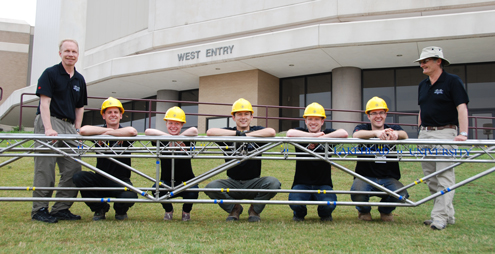
THUNDER BAY – Lakehead University’s Civil Engineering Steel Bridge Team fared well in all seven scoring categories at the 20th annual AISC/ASCE US National Student Steel Bridge Competition to win first place, beating 47 other universities. Lakehead is the only Canadian team to place in the top five overall since the inception of the competition and the first Canadian team to win the competition. Hosted by Texas A & M University, May 20 – 21, 2011, the annual competition attracts participants from across North America.
One of only two Canadian teams to make it to the national level of the competition, Lakehead’s steel bridge ranked well in all seven scoring categories. Their bridge took first place in three categories – assembly time, lightness, and structural efficiency; second place in construction economy; fifth place for stiffness; sixth place for display (aesthetics); and placed FIRST OVERALL to win the competition.
The five-member Steel Bridge Team, comprising graduating students Damien Ch’ng, Dave Enns, Cory Goulet, Chris Kukkee, and Kristin Myles, with faculty advisors Dr. Tony Gillies and Dr. Timo Tikka, travelled to Texas A & M University to compete against forty-eight universities which qualified through eighteen regional competitions that saw over 200 universities participate for an invitation to the National Competition. Lakehead’s team earned its invitation by placing first at the Midwest Regional Qualifier Student Steel Bridge Competition, hosted by the University of North Dakota in Grand Forks, ND, in March 2011.
Student teams come to the steel bridge competition prepared to build a bridge that they have conceived, designed, fabricated, erected, and tested to meet rigorous competition specifications and optimize performance and economy. The models are erected under simulated field conditions, and are then load-tested by judges at the host university. The specifications for the bridge change from year to year, constantly challenging the skills of civil engineering students from universities and to ensure that competitors must design and build new bridges.
This year, teams were faced with constructing a deck bridge to span a scenic river in a state park and carry utilities to a new welcome centre and campground. In addition, the bridge had to provide clearance for recreational boaters and protect sensitive wetlands.
Lakehead University’s five-member student team used computer modeling to examine more than ten different bridge configurations before selecting a final design. The students learned and refined use of metal fabrication hand tools, welding, and a metal lathe, and learned how to program a CNC milling machine for the fabrication of bridge components.
Drs. Tony Gillies and Timo Tikka are thrilled with Lakehead’s performance. “Success in intercollegiate competition requires outstanding teamwork and project management,” says Dr. Gillies. “These future engineers have been incredibly innovative, professional, and efficient. Their elegant bridge design solution for this year’s competition was the lightest and fastest built bridge in the competition, yet performed superbly in structural efficiency (a combination of bridge weight and stiffness under loading), which is a measure of design excellence.”
“Although Lakehead’s teams are veterans of the competition, it’s impossible not to be anxious in this competitive environment where students are scored on how fast they can assemble their bridge,” explains Dr. Tikka. “It gets really nerve wracking when the assembled bridges are loaded with 2500 pounds of angle iron to simulate a loaded truck crossing the bridge. This is nearly eighteen times more than the weight of the bridge. It’s made even more stressful because the placement of the loading is determined by the roll of a dice at the team captains’ meeting the night before competition day. Teams have to anticipate six possible load cases prior to the competition.” Bridges are scored on strength and deflection, taking into account the weight of the bridge. In the end, the bridge with the best performance and lowest cost wins the competition.
“The Lakehead team is grateful to numerous local and national sponsors whose support makes it possible for us to participate in what has become one of the premier competitions for Civil Engineering students,” adds Dr. Gillies. “It’s a wonderful feeling to know we continue to do our sponsors proud while supplementing the education of our civil engineering students with a comprehensive, student-driven project experience.”
Faculty Advisor Dr. Timo Tikka, says “I am so proud of the hard work of this team. They have devoted thousands of hours designing and fine-tuning their bridge to arrive at a structure that, what can I say? It’s simply world-class. I was especially delighted to hear this team talking throughout the Texas competition. Lakehead was by far the most vocal group and had the best communication. They worked as a team. They performed as a team. And they won as a team.”
Next year, a new team hopes to maintain Lakehead’s incredible tradition of performance at the national competition to be hosted by Clemson University in May 2012.

